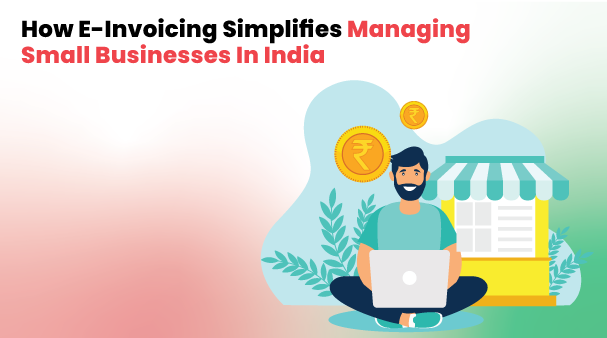E-invoicing compliance was a breakthrough facility introduced under the GST law. Considering the plight of the taxpayers where compliances were becoming redundant, e-invoice removed this redundancy by interlinking the e-invoice portal with GST common portal and e-way bill portal. Small businesses majorly benefitted from this move.
What Is E-Invoicing?
E-invoice, also known as electronic invoice, is a system where the GSTN electronically authenticates the B2B transactions. The entire process of generation and validation of e-invoices is facilitated by the e-invoice portal, also known as Invoice Registration Portal (IRP). A specific identification number, also known as Invoice Reference Number (IRN), is issued against each invoice. This ensures that a particular invoice with the same reference number in the same financial year is not issued twice.
However, a question arises as to how e-invoicing in India has benefited the small businesses? Let’s find out!
How Does E-invoicing Benefit Small Businesses In India?
E-invoicing compliance is implemented in a staggered manner. With effect from 1stApril 2022, taxpayers with a turnover of INR 20 crores or more must comply with e-invoice requirements. While it may seem like an added compliance rather than convenience, let us clear that e-invoice made compliance a lot more convenient. Following are the ways in which e-invoice management is helping out small businesses
- Reduction in Frauds:
E-invoice has proved to be instrumental in curbing tax evasions and frauds. With e-invoices, the transactions are online approved from the Invoice Registration Portal. As the transactions are recorded digitally and cannot be modified, it makes keeping track of the transactions simple.
- Timely Payments:
Payments can be delayed if the credit is not passed on to the buyer on time. As the GST law is holding a tight grip on the flow of ITC, it has become important for suppliers to ensure that they file their returns on time in order to pass on the ITC to the buyers. Once the e-invoice is uploaded to the IRP, the details are intimated to the buyer. Thus, the buyer is satisfied with the timely reporting of the details by the supplier, and eventually, it leads to timely payments.
- Removing Redundancy in Compliance:
As discussed earlier, the e-invoice portal is linked with the GST common portal as well as the e-way bill portal. The benefit of this interlinking is that the details furnished in the e-invoice portal get auto-populated in the GST common portal and the e-way bill portal. Therefore, for filing GSTR-1, you do not need to upload all the details again. Also, for generating an e-way bill, you just need to enter the vehicle details, and your e-way bill is ready. Thus, e-invoice acts as a multi-purpose reporting solution for GST compliances.
- Time-saver:
Invoicing for small businessesis no more time-consuming. E-invoices can be accessed from anywhere and through any device. This has made the accounting process effective and easy. Reconciliation has become simple with tracking of all the transactions through e-invoices, thus freeing up a lot of time from mundane administrative work.
- Data Loss Relief:
Physical invoices can be lost. Invoice is one of the major criteria for claiming ITC. Also, this can lead to inaccuracies in accounting, recording, and auditing of transactions. However, e-invoices can be downloaded any number of times from the portal or through the scanning of QR codes. Thus, going paperless has become easier with e-invoices, and taxpayers are relieved from the loss of invoices.
- Accuracy in Filing Returns:
This is one of the major benefits ofe-invoicing compliance. Apart from removing redundancy in compliance, it also ensures that the compliance is accurate. Inaccuracies in compliance can be the reason for the levy of fines, penalties, or interest. It is possible that some invoices may go unrecorded due to human error or other reasons. This can lead to the omission of reporting, which can, in turn, lead to a levy of interest due to a delay in the discharge of tax amount. As the GSTR-1 gets auto-populated, it ensures that all the invoices get reported to the GST portal.
How Does E-invoicing Benefit the Government?
E-invoicing has proven to be instrumental in reducing taxation frauds and increasing transparency. As the e-invoice, once generated, cannot be modified subsequently, it has been significant in curbing tax evasions. Also, it has led to a significant reduction in the issuance of fake invoices, which will result in a genuine claim of ITC by the taxpayers. The buyers will compel the sellers to issue the e-invoices in order to claim ITC, which will ensure that the tax is deposited with the government.
Further, the invoice details can be checked instantly by scanning the QR code that is mandatorily affixed to the e-invoices. Apart from helping the taxpayers, this has also benefited the tax officers to check the validity and details, especially when the goods are in transit.
How do E-invoices Facilitate Remote Conduct of Business?
As the world is shifting remote, there has been a significant change in invoice management. While earlier, the office-based team used to process all the invoices received in hard copies or via mail, now people work from remote locations. Further, now businesses are not limited to local, but now people are selling nationwide as well as fulfilling international orders, thanks to e-commerce and the internet revolution.
Therefore, paper invoices have become less attractive. Also, the buyers are mandated to have invoices with them in order to claim ITC. It is not feasible to issue and deliver paper invoices. The ultimate outcome of holding to this traditional practice of issuing invoices will be delayed payments and claiming of ITC by the buyers.
E-invoice management has automated the system of invoice delivery. It is not upon the supplier’s shoulders to deliver the invoice to the buyer, as once the e-invoice is generated and validated by the system, it is automatically delivered to the buyer through a registered mail ID.
How Is WeP Helping Small Businesses To Adopt E-Invoices?
WeP Digital provides a complete e-invoicing solution for small businessesto help ease their GST compliances. Its ability to directly integrate with your existing ERP software can provide for real-time e-invoice generation. This is especially suited for businesses that have a volume of transactions and correspondingly generate a large number of invoices.
Further, it has been designed to take a load of lakhs of transactions without compromising on the key performance parameters, i.e., speed, responsiveness, and accuracy. Also, your data is secure in AES 256 bit encryption, thereby delivering a 100% secure and safe solution to the customers.
Thus, it can be said that compliance has been made easy and accurate with the introduction of e-invoicing in India. As the world is shifting to remote working, so should your invoicing. How do you invoice?

